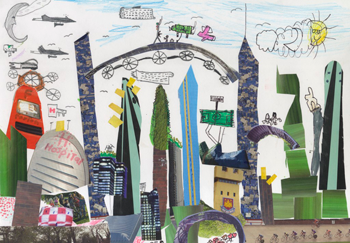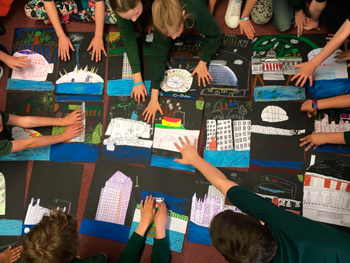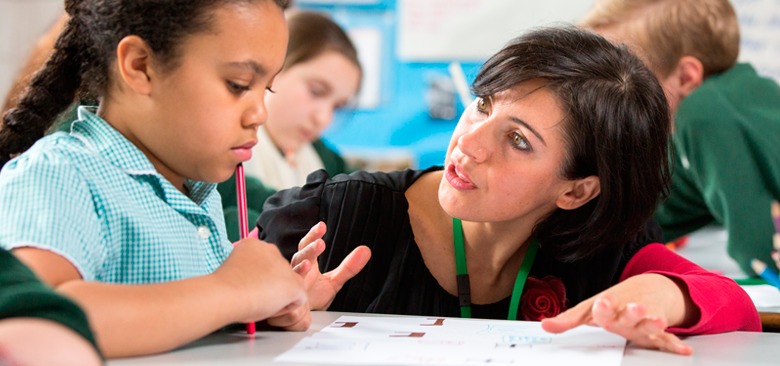Drawing and creating buildings of the future is a common in our childhood and ‘Little Architect’ does not want us to abandon our capacity to observe our surroundings and to imagine cities that will make us happy.
In order to open our society’s eyes to the importance of architecture that is sustainable, accessible, responsible and practical for its users we have to start by engaging children in the world that surrounds them, awakening their interest in their environment, in their cities and in their fellow citizens. This is something that the Andalusian architect Dolores Victoria Ruiz Garrido, who has been based in London for last 5 years, had really clear in her mind when she launched her project ‘Little Architect’.
Ruiz Garrido, who also runs her own architect’s studio in Spain (called ‘Semisótano’) and is the co-founder of the contemporary art platform SCAN, knew, both as an architect and a mother, that in order to change the relationship between architects and society it was essential to start by educating our children in disciplines such as design, architecture, urban planning and drawing.

Drawing and creating buildings of the future is a common in our childhood.
‘Little Architect’ is an educational programme through which architecture is taught to children from the ages of 5 to 11 in London’s primary schools, fostering the children’s creativity by encouraging them, among other things to imagine and to draw cities or buildings of the future. The children learn to observe and appreciate architecture, understanding the importance that it has in the day-to-day lives of the people that inhabit those cities, helping the children to become more proactive citizens and therefore, more critical of any development in their urban surroundings.
“If we could have a generation of children that is educated in contemporary architecture, it would suddenly become really easy to find support for campaigns like the one led by Richard Rogers and the Twentieth Century Society to save, for example, the Robin Hood Gardens building from demolition,” adds Dolores Victoria.
The key to the success of this programme is without doubt the fact that it moves away from the typical circles and audiences of the schools of architecture and that it establishes its courses directly in schools, working collaboratively with teaching staff to include contemporary and even utopian architecture in the current school curriculum.
Its main objective is to teach young members of the community that there are other options and that they can demand better urban spaces which are more appealing to their users, and that, at the same time, they learn to be more aware of the importance of protecting our architectural patrimony. We need sensible urban planning and sustainable actions. Nowadays no one disputes the fact that primary education is by far the most relevant stage of education, the one that gives shape to our society, whilst later stages of education serve to create professionals.

Little Architect’ at Betty Layward School. Hackney, London.
Another of the reasons which led this architect to start up this programme is the fact that the children of today are getting the wrong message about what the ideal house should be like. Toys, films, books and stories propagate the idea that this has to be a “beautiful house with a garden and a garage”, something which in an overpopulated urban environment like London turns out to be rather unaffordable, and a model that makes no sense to implement, given its unsustainability. “This is a serious issue! If we do not improve the way that architecture is being perceived by today’s children and if we do not talk to them in a positive was about high-rise architecture, communal spaces, etc. then we are betraying them and leading them towards a future of deception and of unfulfilled dreams,” she tells us.
“Customers, consumers and service users should think about the future and the present, not only the past! The past had moments of glory, but the future is ours,” she concludes.
The project forms part of the programme run by the Architectural Association School of Architecture, the oldest school of architecture in the United Kingdom and considered one of the best in the world, and through the two courses that have taken place up until now, since 2014, in schools they have given classes to more than 3000 children in London, in 27 different primary schools.
Drawing and creating buildings of the future is a common in our childhood and ‘Little Architect’, under the direction of Dolores, does not want us to abandon our capacity to observe our surroundings and to imagine cities that will make us happy.
[su_note note_color=”#eaeae9″]Translated by Stephanie Back. [/su_note]
————————
Photos © ‘Little Architect’ / Cover Image © Capco (Capital & Counties).
Full info: www.aaschool.ac.uk/STUDY/VISITING/littlearchitect

